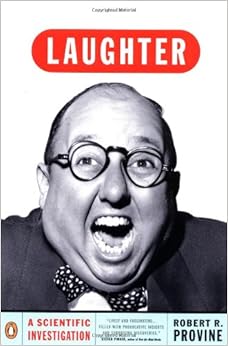
Free Downloads Laughter: A Scientific Investigation

Do men and women laugh at the same things?Is laughter contagious?Has anyone ever really died laughing?Is laughing good for your health?Drawing upon ten years of research into this most common-yet complex and often puzzling-human phenomenon, Dr. Robert Provine, the world's leading scientific expert on laughter, investigates such aspects of his subject as its evolution, its role in social relationships, its contagiousness, its neural mechanisms, and its health benefits. This is an erudite, wide-ranging, witty, and long-overdue exploration of a frequently surprising subject.

Paperback: 272 pages
Publisher: Penguin Books; Reprint edition (December 1, 2001)
Language: English
ISBN-10: 0141002255
ISBN-13: 978-0141002255
Product Dimensions: 5.4 x 0.6 x 7.9 inches
Shipping Weight: 8.8 ounces (View shipping rates and policies)
Average Customer Review: 3.1 out of 5 stars See all reviews (20 customer reviews)
Best Sellers Rank: #361,508 in Books (See Top 100 in Books) #35 in Books > Humor & Entertainment > Humor > Theories of Humor #304 in Books > Science & Math > Experiments, Instruments & Measurement > Methodology & Statistics #871 in Books > Health, Fitness & Dieting > Psychology & Counseling > Neuropsychology

Don't expect to get lots of laughs by just reading _Laughter: A Scientific Investigation_ (Viking) by Robert R. Provine. It's not merely that Provine is covering a serious subject. He is as good as his word: his book is a scientific investigation, and he is neuroscientist by profession who has done original research on laughter published in such non-newsstand rags as _Ethology_ and _Bulletin of the Psychonomic Society_. And it's not that Provine is an unentertaining, dour writer; he has a light touch, and good explicative skills, he is happy to share a joke, and his stories about some of the ways he has done experiments are funny. For instance, we can share his bemusement over his initial explorations of why people laugh; he got a group into a clinic and played them funny tapes. He failed to get anything but a few chuckles. It was his first demonstration that laughter was a social behavior, not a laboratory one. He went on to study people in social situations.Similarly, the reason you can't expect to laugh much from reading Provine's book is found in the book itself. Laughter is not something you can most reliably expect to do alone reading a book; it is something we do as a social behavior. Its "sociality," the ratio of social to solitary performance of the act, is very high. Provine had his undergraduate students keep logs of their behavior, including laughing, and found that we are thirty times more likely to laugh when with someone else. Another study showed that eye contact between two companions increases the likelihood of laughter. Laughter has a nonlinguistic role of holding people together.
Laughter: A Scientific Investigation Spitz and Fisher's Medicolegal Investigation of Death: Guidelines for the Application of Pathology to Crime Investigation Kennewick Man: The Scientific Investigation of an Ancient American Skeleton (Peopling of the Americas Publications) Diversity and the Tropical Rain Forest: A Scientific American Library Book (Scientific American Library Series) In Such Good Company: Eleven Years of Laughter, Mayhem, and Fun in the Sandbox Funny!: Twenty-Five Years of Laughter from the Pixar Story Room (The Art of...) This Time Together: Laughter and Reflection Lincoln Tells a Joke: How Laughter Saved the President (and the Country) Chicken Soup for the Kid's Soul: 101 Stories of Courage, Hope and Laughter (Chicken Soup for the Soul) Laughter Is Sacred Space: The Not-so-Typical Journey of a Mennonite Actor Front Porch Tales: Warm Hearted Stories of Family, Faith, Laughter and Love The Notebook of Elbert Hubbard: Mottos, epigrams, short essays, passages, orphic sayings and preachments : coined from a life of love, laughter and work A Tablespoon of Love, A Tablespoon of Laughter: Cookies & Casseroles, Prayers & Praises, Soups & Stories, & Joy ... All the Way Laughter in Ancient Rome: On Joking, Tickling, and Cracking Up (Sather Classical Lectures) The Laughter of the Sphinx Between Heaven and Mirth: Why Joy, Humor, and Laughter Are at the Heart of the Spiritual Life Subversive Laughter: The Liberating Power of Comedy Laugh Your Way to Happiness: The Science of Laughter for Total Well-Being In This House, We Will Giggle: Making Virtues, Love, and Laughter a Daily Part of Your Family Life Laughter - An Essay on the Meaning of the Comic



